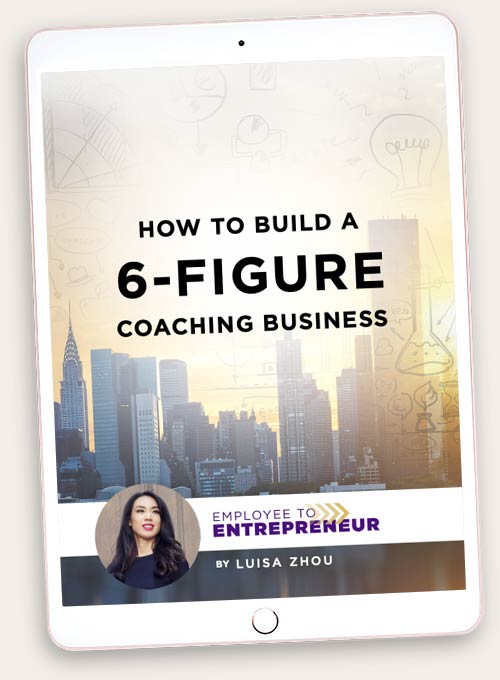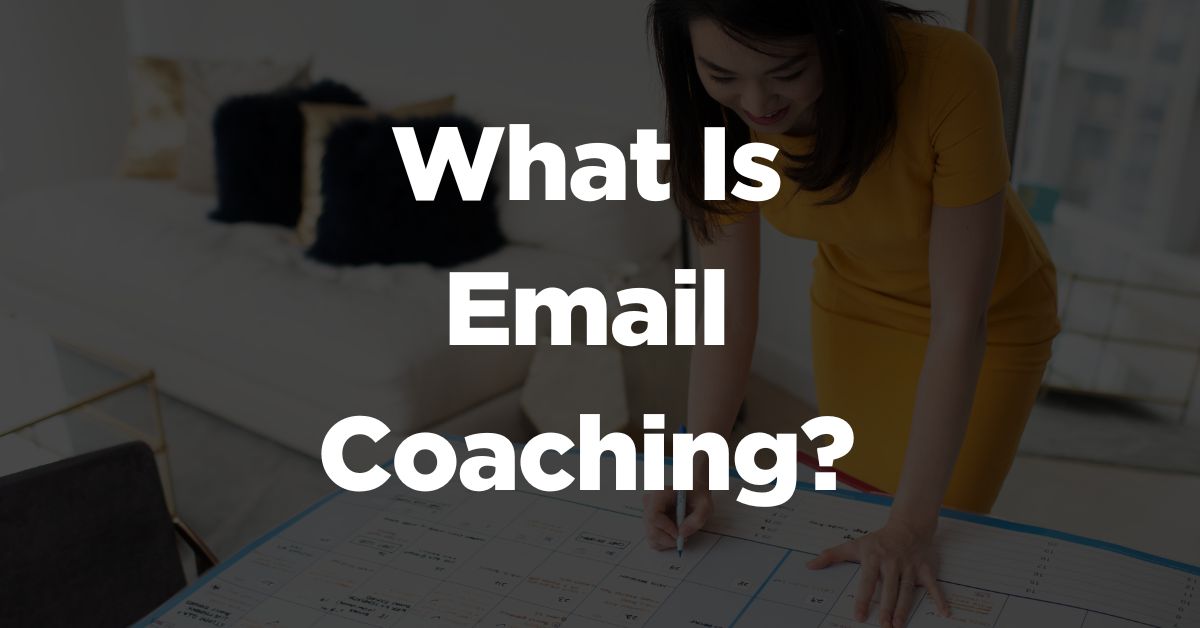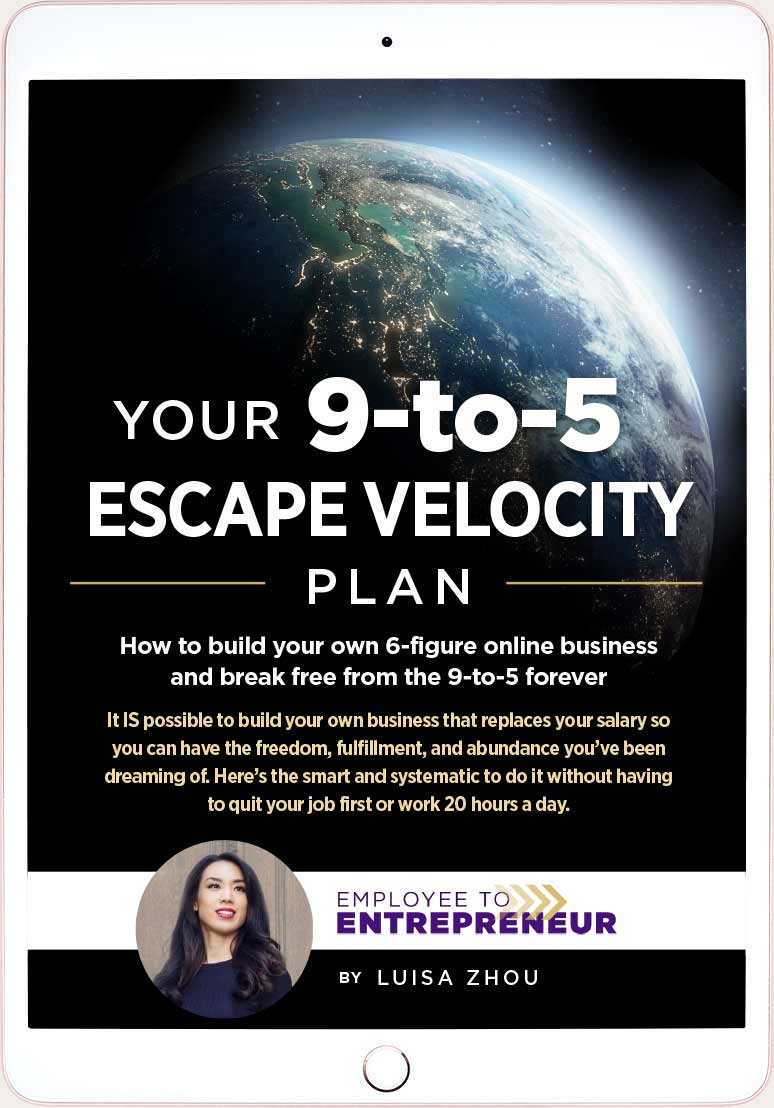What does email coaching entail and how could it help YOU as a coach?
You’re in the right place. As a coach, using email can be a very effective way to connect with your clients.
If you…
- Want to support your clients in getting the best results possible
- Work with clients from different time zones
- Travel a lot
… then email is a great option. Keep reading – we’re about to look at why that is.
What is email coaching?
As the name suggests, coaches offer email coaching to communicate with their clients using email.
So, your clients can ask questions and check in about their progress just as they would on a live call. The big difference is the medium you use to communicate back and forth. (We’ll talk more about the implications of using email a little later.)
But for now, what’s one benefit of email coaching?
You can adjust it to fit your needs. For example, some coaches prefer using email exclusively for client communication in their coaching businesses.
At the same time, many coaches use email as a way to offer support in between regularly scheduled virtual meetings. So, if a client has a pressing question, for example, they can reach you and get an answer before the next call.
(Although… another option is to use a tool like Voxer or WhatsApp. Ultimately, it comes down to your needs.)
Another way to use email in your coaching?
Offer it as an add-on bonus that clients can take advantage of when they buy your online course or similar offer.
Get the Ultimate Guide
for building a
6-Figure Coaching Business so you can achieve more freedom!
(This is something I’ve done myself for my coaching clients, so I know it’s effective. But don’t worry, I’ll cover this in more detail in a second.)
Either way, email coaching works for various coaching niches – for example, life coaching, business coaching, health coaching, and mindset coaching. (Just to name a few, but you can use email coaching irrespective of your niche.)
Now that we’ve gone over what email coaching involves, let’s dig deeper to figure out WHY people would prefer communicating with you through email in particular.
Why do clients choose email coaching?
These days, there are PLENTY of different ways to communicate remotely. So… what makes email a great choice in your coaching process? That’s what we’ll cover next.
Flexibility
One great thing about online coaching is that you’re not limited to meeting with clients who live in your city. You can coach people who live literally anywhere in the world. If you and your clients are based in different time zones, travel often, or just have different schedules, finding a time to meet that works for everyone can be complicated.
Using email, your clients can send you questions on their own time, and you can respond at a time that works for you. It’s a win-win.
Lower barrier to coaching
Let’s say you have significant expertise to share with your clients, but … You fall into one (or all) of these categories:
- You consider yourself more on the introverted side
- You have social anxiety
- You work better when you have time to think through a question before giving an answer
In that case?
Email coaching can ultimately help you build confidence in your abilities as you become a better coach.
Plus, it can also be ideal if your dream CLIENTS are introverted or just prefer the convenience of being able to express themselves in written format.
Keeping track of coaching
When you communicate through text, it’s much easier to keep track of different clients and revisit their questions if necessary.
Another benefit is that you can go through your conversations and look at how your clients have progressed over time.
But… if you communicate mostly through video meetings, it can be much more complicated to shift through hour-long calls to revisit past questions.
Even if you record the videos.
Alright, now that we’ve gone over why clients are attracted to email coaching, let’s talk about what the biggest advantage is (for you AND your clients) and some pros and cons.
What is the biggest advantage of email coaching?
Email coaching gives you huge freedom and flexibility as a coach.
Need to travel?
Or have an unexpected appointment and can’t make it to a live meeting?
You can reply to client questions on your own time.
So, in a nutshell, what makes email coaching a great option?
This: It helps you create a schedule that works for you and your clients.
And that’s one of the big reasons to become a coach:
Having that flexibility to work around your schedule rather than having to schedule everything around your work.
Now let’s go over more benefits of using email for coaching.
Pros of email coaching
Flexibility – No need to meet with your clients live, which means you don’t have to block off specific times during your day or week for lengthy calls.
Scalability – As your experience grows, you’ll be able to spend less time answering questions, which will help you work less and earn more and work with more clients.
Remember: Your clients are after RESULTS. As long as you can offer those, they don’t care if you’re spending 10 hours or 10 minutes replying to their messages.
Easy to add on as a service – Simply adjust your current coaching services offer to include email support.
Access to more clients – You can coach clients no matter what your respective time zones are.
High-value bonus – Offering email coaching as a bonus instantly makes your course much more valuable.
People will get faster results with your self-study course thanks to the advice you offer.
In my SEO course, Clients Come to Me, we offer email coaching just for that reason – to help people get the results they want.
But what are the cons of communicating by email?
Let’s take a look.
Cons of email coaching
Hard to build trust – When you communicate with people exclusively through email, you don’t get the benefit of seeing them face-to-face and building a more “human” connection with them.
The result?
Get the Ultimate Guide
for building a
6-Figure Coaching Business so you can achieve more freedom!
It can be harder to create a good rapport and have them open up about their challenges, goals, and so on.
Ultimately, that means it’s harder to help email coaching clients where they’re at… and that means it can also be harder to retain them.
Difficult to get the right information – When you’re on a call with a client, you can dig deep into their unique situation and get clarity on a bunch of different points that can help you customize a plan to help them.
But with email?
You don’t get as much of that clarity because you’re just typing messages back and forth.
Plus, it can take days to get a response from your client, and you don’t get the benefit of hearing their tone of voice, reading their facial cues, and more. Clearly, those are downsides to using written communication only.
Alright, so we’ve looked at some pros and cons to consider. And now, maybe you’re wondering… How can I offer email coaching myself?
That’s what we’ll look at next.
How to offer email coaching
Now you know what email coaching is.
But how do you offer it to your clients? Here’s how to do that effectively.
Create a package
Creating a coaching package is an ideal way to get organized so you can help clients work methodically – and ultimately maximize their results.
This applies no matter what your niche is.
But how can you go about creating a standout email coaching package? Here are four questions to ask yourself:
1. What result does my email coaching offer?
For coaching to be worth investing in, you have to be able to offer results.
What kinds of results?
It depends on what your niche is, but they should be measurable.
For example, if you’re a health coach, your offer might be that by the end of your coaching, your clients have lost a certain number of pounds or built up a new routine.
Your coaching package can offer intangible results, too. For instance, will your clients be happier, less stressed, or better at setting boundaries with other people?
Ultimately, they need to come away from your coaching equipped with a meaningful payoff you’ve helped them get.
And the better the payoff, the better the testimonials you’ll receive, so this is an important long-term strategy for growing your business.
2. How long is my coaching package?
To give your offer structure and pace it well, it’s important to know how long you want it to last. So, for example, some coaches like offering three-month-long email coaching packages, while others prefer going longer.
Ultimately? It depends on you.
But if you’re just getting started, I recommend offering three months of coaching at a time.
Why?
There are a few reasons for this.
For one thing, three months is long enough to give your clients results… WITHOUT it being too long of a commitment for you or your clients.
And two, if for whatever reason you don’t work well with a particular client, you won’t be “stuck” with them for a long period of time.
3. What does my coaching package include?
Once you’ve decided how long you want your coaching package to be, you can decide what level of support you want to offer.
For that, you have several options: For example, you could choose to offer weekly or bi-weekly phone calls and provide email support in between as an add-on.
Or, you could decide to offer email support exclusively. But with email, it can be tempting to let clients contact you as much and as often as they want… which leads to the next point:
4. What are your boundaries?
In other words, how often can clients email you, and when can they expect to hear back?
Setting clear boundaries as part of your coaching package is an ideal way to reduce overwhelm and make sure you and your clients are on the same page.
After all, you want to help, but… You ALSO have a life outside of work.
Which means?
Answering “urgent” emails at 2 a.m. on a weekend isn’t sustainable.
So, here are some communication options that you could include in your package to set reasonable boundaries and avoid burnout:
- Clients can contact you anytime, but if they reach out on a weekend or holiday, you won’t be available to respond until the following business day
- During the week, clients can expect an answer within [blank] hours
- Clients can only send one email at a time
What boundaries make sense for you? Think about it… You can always tweak these based on your situation.
Price your package
Some people say you have to reduce how much you charge for email coaching because it’s less work than traditional coaching. But actually? I don’t recommend doing that.
Get the Ultimate Guide
for building a
6-Figure Coaching Business so you can achieve more freedom!
Why?
Because people are coming to you based on your expertise, NOT your time.
So, instead, I recommend offering email support in addition to your standard coaching calls. Ultimately, the quality of your advice doesn’t change based on what medium you use.
Whether you’re sharing your knowledge via email or video call, keep in mind that results are the most important thing.
And again, your clients don’t care about how long you spend helping them as long as they get the support they need.
Which means?
Spending ten minutes typing an answer to a specific question or spending an hour talking on Zoom can have similar results.
Okay, up next: What email coaching tools should you use as a coach? Let’s take a look.
The best email platforms for coaches
There are plenty of tools out there that can help make your life so much smoother and easier as a coach.
For example, I recommend getting set up with Google Workspace.
Why?
For one thing, it’ll give you access to a personalized business email address (which will make your email coaching offer that much more professional).
Plus, Google Workspace includes a bunch of different tools all in one place, like Gmail, Docs, Agenda, Meet, Chat, and more.
And you can even connect a domain if you have one, which is really convenient.
You’ll also need an email platform you can use to build an email list and send out emails..
For that, I recommend using either Mailchimp or ActiveCampaign, since both are really intuitive to use.
Not sure how to do email marketing to maximize sales and growth? Don’t worry, I made a video to help you with that:
Next steps
So, there you have it!
Now you know what email coaching is and some of the pros and cons.
As you can see, it’s a way to offer your clients great value… WITHOUT having to deal with the downsides of live communication.
After helping thousands of students hit six and even seven figures as coaches, here’s what I want you to know:
Yes, you have what it takes, and no, it’s not that difficult.
Want to get started building your coaching business?
Get my blueprint to start your six-figure coaching business.

Want to Build a 6-Figure Coaching Business So You Can Achieve More Freedom?
Get Instant Access To My FREE Ultimate Guide Below!
When you sign up, you’ll also receive regular updates on building a successful online business.
Read more:
How to Design and Price Your First Coaching Package
How To Create Your Signature Coaching Program [+Template]
How to Plan & Structure Highly Effective Coaching Sessions








